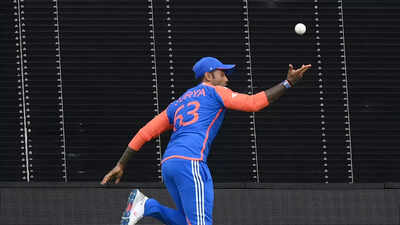The International Cricket Council (ICC) has announced significant alterations to the playing conditions across Test, ODI, and T20I formats. These changes, focusing on over rates, ball usage, boundary catches, concussion protocols, and wide deliveries, aim to enhance the game's flow and fairness.

To combat slow over rates and minimize delays, a stop clock will now be permanently implemented in Test cricket, mirroring its use in white-ball formats. The fielding team must commence a new over within 60 seconds of completing the previous one. Teams will be issued two warnings per innings, with subsequent breaches incurring a five-run penalty. Crucially, these warnings reset every 80 overs, coinciding with the availability of a new ball.
In One Day Internationals (ODIs), the use of two balls will be confined to the initial 34 overs. For the remaining 16 overs, the fielding side will have the option to select one of the two balls to continue with, strategically managing ball wear and tear.
The rules governing boundary catches have been updated. Fielders making airborne contact with the ball beyond the boundary must ensure their final contact point is entirely within the field of play to complete a legal catch. Should they step out and jump again, they are permitted only one additional touch before landing inside the boundary.
Teams will now be required to pre-nominate concussion substitutes. Any player diagnosed with a concussion will be mandated to observe a seven-day rest period before being permitted to return to competitive play, ensuring player safety.
A revised wide ball rule is set for trial in white-ball cricket. The batter’s position at the moment of delivery—rather than any subsequent movement—will determine the judgement of wides. Deliveries passing between the leg stump and the extended protected area marker at the popping crease will no longer be called wide. However, deliveries passing behind the batter's legs may still be deemed wide.
To aid umpires, the protected area marker will now extend to the popping crease, serving as a visual aid.
The Decision Review System (DRS) will now utilize the actual physical outline of the stumps and bails to define the wicket zone, improving the accuracy of LBW (Leg Before Wicket) decisions.
In addition to the existing five-run penalty for a deliberate short run, the fielding team will now have the authority to choose which batter takes strike for the subsequent delivery.
In domestic first-class cricket, a significant change allows for a like-for-like player to replace a player who suffers a serious on-field injury after the match has commenced, including during warm-ups, for the remainder of the game.
The new Test playing conditions were effective from the Sri Lanka vs Bangladesh Test on June 17. The revised ODI and T20I rules will be implemented from the same series, starting with the first ODI on July 2 and the T20Is from July 10. All international matches beyond these dates will adhere to the updated regulations.
Newer articles
Older articles
 Indian Astronaut Joins ISS: Shukla's Mission Ushers in New Era for India's Space Program
Indian Astronaut Joins ISS: Shukla's Mission Ushers in New Era for India's Space Program
 Ashada Gupt Navratri 2025: Unveiling Dates, Sacred Rituals & Hidden Significance
Ashada Gupt Navratri 2025: Unveiling Dates, Sacred Rituals & Hidden Significance
 Rishabh Pant's Unconventional Batting Redefining Cricket, Says Greg Chappell
Rishabh Pant's Unconventional Batting Redefining Cricket, Says Greg Chappell
 Moto G54 Price Slashed in India: Check Out the New, Lower Cost
Moto G54 Price Slashed in India: Check Out the New, Lower Cost
 JPG to PDF: A Graphic Designer's Guide to File Conversion and Quality Preservation
JPG to PDF: A Graphic Designer's Guide to File Conversion and Quality Preservation
 'The Traitors' Star Apoorva Mukhija Accuses Sudhanshu Pandey of Misogyny and Verbal Abuse After On-Screen Drama
'The Traitors' Star Apoorva Mukhija Accuses Sudhanshu Pandey of Misogyny and Verbal Abuse After On-Screen Drama
 Van der Dussen to Captain South Africa in T20I Tri-Series Against New Zealand and Zimbabwe
Van der Dussen to Captain South Africa in T20I Tri-Series Against New Zealand and Zimbabwe
 20 Minutes to a Healthier Brain and Heart: Neurologist's Simple Strategies to Combat Cholesterol, Blood Pressure, and Dementia Risk
20 Minutes to a Healthier Brain and Heart: Neurologist's Simple Strategies to Combat Cholesterol, Blood Pressure, and Dementia Risk
 England's Audacious Batters Claim They Could Have Chased Down 450 in First Test Win Over India
England's Audacious Batters Claim They Could Have Chased Down 450 in First Test Win Over India
 Popular Finance YouTuber "financewithsharan" Hacked: Security Measures to Protect Your Account
Popular Finance YouTuber "financewithsharan" Hacked: Security Measures to Protect Your Account